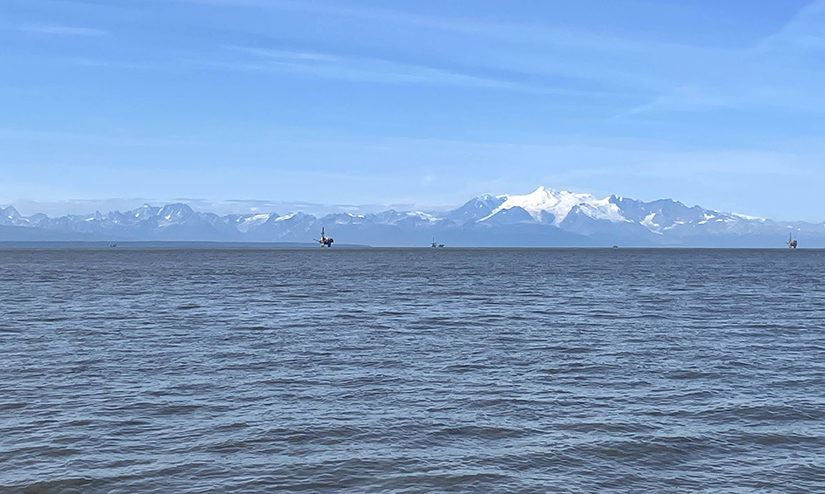Alaska’s Wind, Wave, Tidal Resources Could Help State Meet Future Energy Needs, NREL Determines

NREL researchers have determined offshore wind turbines in Cook Inlet, Alaska, are a feasible option for generating renewable energy from ocean-based resources. Photo by Levi Kilcher, NREL
Offshore wind makes sense for decarbonizing energy production and building energy security and independence when it comes to ocean renewable energy production in Alaska's Outer Continental Shelf (OCS), according to an analysis by researchers at the National Renewable Energy Laboratory (NREL).
Their new report, “Feasibility Study for Renewable Energy Technologies in Alaska Offshore Waters,” was conducted for the Bureau of Ocean Energy Management (BOEM) to evaluate the feasibility of ocean energy projects in federal waters, including wind, wave, and tidal resources. The study area also included state waters outside of BOEM's jurisdiction to allow broader consideration of tidal and wave energy that often have the best resources closer to shore.
“Offshore wind development could be a viable option in Alaska waters, particularly in areas closest to Alaska's population centers,” said Elise DeGeorge, a senior project leader at NREL and a co-author of the report, which examines ocean renewable energy opportunities in Alaska in the next 10–20 years.
“Alaska is rich in natural resources, and that includes offshore renewable energy resources,” said Givey Kochanowski, director of BOEM's Alaska OCS Region. “Near Anchorage, Cook Inlet alone has significant wind- and tidal-energy potential. We are happy to work with any interested party to help explore opportunities for tapping those vast resources.”
The 131-page report, which was written by 11 researchers working in eight different areas, recommends the Alaska office of BOEM assess interest in demonstrating the potential for ocean energy through a pilot study or through other critical research initiatives.
Alaska's Outer Continental Shelf holds the potential to generate 3,800 gigawatts of electricity from wind, wave, and tidal resources. Because of practical constraints such as the long distances to customers and potential conflicts with other ocean users and wildlife, however, only a small fraction of these resources can practically be developed. Alaska already derives about 30% of its electricity from renewable sources, primarily hydropower. The rest comes from fossil fuels, but the cost is expensive in rural villages because of the reliance on diesel generation and having to transport the necessary fuel.
The researchers examined the ocean-based resources available around the state for producing energy and conducted case studies of various hypothetical utility-scale projects. In addition to offshore wind, water, and tides, they also examined the production of clean hydrogen as a longer-term solution to serving end users and creating an external market from the ocean renewable energy produced.
Most Alaskans live in what is known as the Railbelt area, a large section of southcentral Alaska that sits north of Cook Inlet and stretches from Anchorage to Fairbanks. The vast majority of electricity is generated in this same area, primarily from natural gas. Outside of the region, more than 200 remote grids serve rural villages.
The researchers calculated the levelized cost of electricity (LCOE) generated by offshore wind and tides.
“Wave energy could also be a viable option in certain regions, but we didn't calculate LCOE as time to commercialization may extend beyond the report's planning period,” DeGeorge said.
In the case studies, the researchers considered 1-gigawatt offshore wind scenarios, both for floating and fixed-bottom turbines, and a 65-megawatt array of tidal devices. The LCOE projections for offshore wind in locations further from Alaska's Railbelt included the clean hydrogen component as one potential external market to make development costs more feasible. The lowest LCOE was for a fixed-bottom turbine in Lower Cook Inlet, at $83 a megawatt-hour.
The tides in Cook Inlet rise and fall by as much as 35 feet, forcing large volumes of water to move in and out, but the LCOE for a tidal array there was still higher than for offshore wind, at $280 a megawatt-hour. NREL researchers are working with the Alaska Center for Energy and Power on finalizing a road map for developing tidal energy projects in Cook Inlet.
The NREL report recommends BOEM remain involved with the existing working groups focused on tidal energy and clean hydrogen.
Learn more about NREL's energy analysis research.
This article has been updated to reflect an editorial change made after its original publication.
Last Updated May 28, 2025
